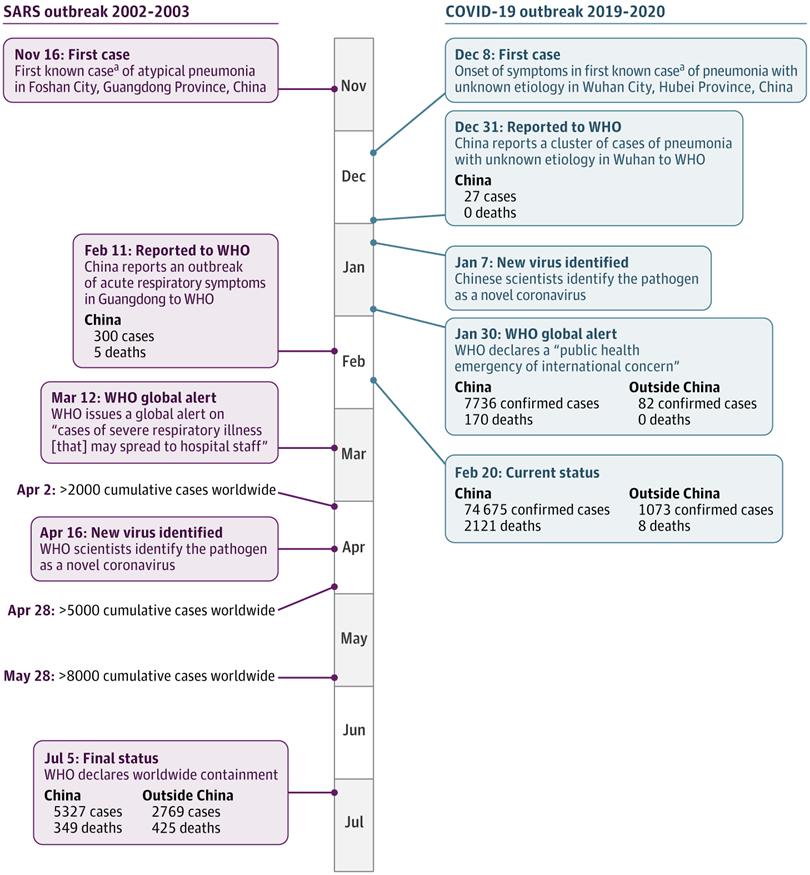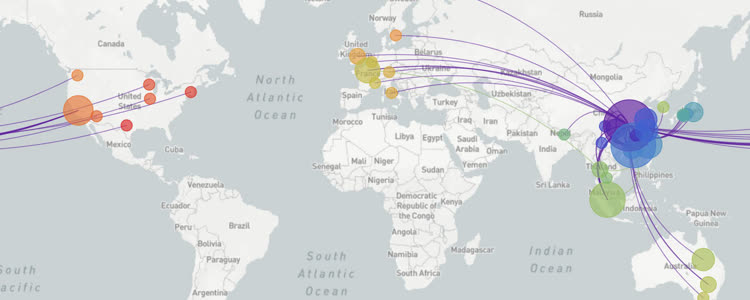|
Characteristics of and Important Lessons From the Coronavirus Disease 2019 (COVID-19) Outbreak in China
Summary of a Report of 72 314 Cases From the Chinese Center for Disease Control and Prevention.
The current COVID-19 outbreak is both similar and different to the prior severe acute respiratory syndrome (SARS; 2002-2003) and Middle East respiratory syndrome (MERS; 2012-ongoing) outbreaks. SARS was initiated by zoonotic transmission of a novel coronavirus (likely from bats via palm civets) in markets in Guangdong Province, China. MERS was also traced to zoonotic transmission of a novel coronavirus (likely from bats via dromedary camels) in Saudi Arabia. All 3 viral infections commonly present with fever and cough, which frequently lead to lower respiratory tract disease with poor clinical outcomes associated with older age and underlying health conditions. Confirmation of infection requires nucleic acid testing of respiratory tract samples (eg, throat swabs), but clinical diagnosis may be made based on symptoms, exposures, and chest imaging. Supportive care for patients is typically the standard protocol because no specific effective antiviral therapies have been identified.
The World Health Organization (WHO) declared the SARS outbreak contained on July 5, 2003. A total of 8096 SARS cases and 774 deaths across 29 countries were reported for an overall CFR of 9.6%. MERS is still not contained and is thus far responsible for 2494 confirmed cases and 858 deaths across 27 countries for a CFR of 34.4%. Despite much higher CFRs for SARS and MERS, COVID-19 has led to more total deaths due to the large number of cases. As of the end of February 18, 2020, China has reported 72 528 confirmed cases (98.9% of the global total) and 1870 deaths (99.8% of the global total). This translates to a current crude CFR of 2.6%. However, the total number of COVID-19 cases is likely higher due to inherent difficulties in identifying and counting mild and asymptomatic cases. Furthermore, the still-insufficient testing capacity for COVID-19 in China means that many suspected and clinically diagnosed cases are not yet counted in the denominator.2 This uncertainty in the CFR may be reflected by the important difference between the CFR in Hubei (2.9%) compared with outside Hubei (0.4%).1,2 Nevertheless, all CFRs still need to be interpreted with caution and more research is required.
Most secondary transmission of SARS and MERS occurred in the hospital setting.
|
Comparative genetic analysis of the novel coronavirus (2019-nCoV/SARS-CoV-2) receptor ACE2 in different populations
The ACE2 gene encodes the angiotensin-converting enzyme-2, which has been proved to be the receptor for both the SARS-coronavirus (SARS-CoV) and the human respiratory coronavirus NL63. Recent studies and analyses indicate that ACE2 could be the host receptor for the novel coronavirus 2019-nCoV/SARS-CoV-21,2. Previous studies demonstrated the positive correlation of ACE2 expression and the infection of SARS-CoV in vitro3,4. A number of ACE2 variants could reduce the association between ACE2 and S-protein in SARS-CoV or NL635. Therefore, the expression level and expression pattern of human ACE2 in different tissues might be critical for the susceptibility, symptoms, and outcome of 2019-nCoV/SARS-CoV-2 infection. A recent single-cell RNA-sequencing (RNA-seq) analysis indicated that Asian males may have higher expression of ACE26. Currently, the clinical reports of 2019-nCoV/SARS-CoV-2 infection from non-Asian populations for comparison are very limited. A study from Munich reported four German cases, all of which showed mild clinical symptoms without severe illness7. However, the genetic basis of ACE2 expression and function in different populations is still largely unknown. Therefore, genetic analysis of expression quantitative trait loci (eQTLs)8 and potential functional coding variants in ACE2 among populations are required for further epidemiological investigations of 2019-nCoV/SARS-CoV-2 spreading in East Asian (EAS) and other populations.
|
|
|
|
Coronavirusís Genetics Reveal Its Global Travels
Random mutations in the SARS-CoV-2 pathogenís genome help researchers track the spread and transmission of COVID-19, the disease it causes.
Several years ago, Richard Neher, an evolutionary biologist at the University of Basel in Switzerland, and his colleagues wanted to monitor changes to the fluís genetic makeup to see if the data would help scientists build more-effective flu vaccines. They developed an online interface that integrated the latest viral sequencing data, analyzed it, and published the results in a publicly available interactive web browser.
ďThen we thought, why just flu, why not other viruses?Ē Neher says. The team built a similar platform to chart the transmission of MERS and Ebola and called the site NextStrain.org. Now, theyíve adapted it to keep track of the genetic tweaks to SARS-CoV-2 as it spreads around the globe and chart the viral lineages on world maps to watch, in nearly real time, as the virus moves from major hotspots in China to smaller pockets in other countries.
These sequences are very, very similar, about eight mutations different than the root. Thatís eight mutations in a 30,000-base sequence. What this tells us is that the virus came from one source, not too long ago, somewhere between mid-November and early December.
Itís a little difficult to interpret the numbers from China right now. The dynamics are changing; the cases are plateauing. We expect this to be a result of these draconian containment measures or quarantine measures that they imposed on half a billion people. There are 70,000 reported cases so the number of infections could be 200,000. It could be 500,000. We donít know because people may be sick at home and stay home because the hospitals are overcrowded and thatís where you could get infected. I donít think we have a good handle on how many cases there were that simply donít show up in any statistic. I would [estimate] some three-fold underreporting at least. There are 70,000 reported cases so the number of infections could be 200,000. It could be 500,000.
|
|
|

